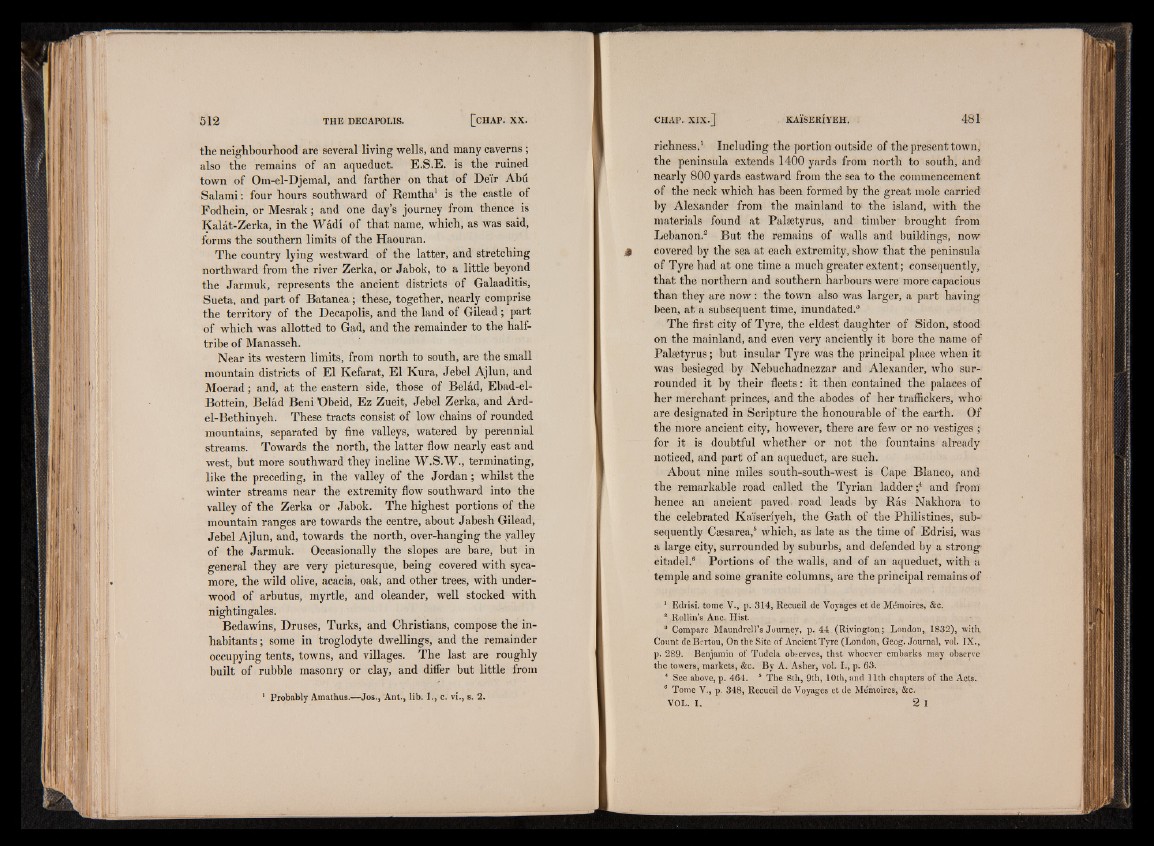
the neighbourhood are several living wells, and many caverns ;
also the remains of an aqueduct. E.S.E. is the ruined
town of Om-el-Djemal, and farther on that of De'ir Abu
Salami: four hours southward of Remtha1 is the castle of
Fodhein, or Mesrak; and one day’s journey from thence is
Kalat-Zerka, in the Wadi of that name, which, as was said,
forms the southern limits of the Haouran.
The country lying westward of the latter, and stretching
northward from the river Zerka, or Jabok, to a little beyond
the Jarmuk, represents the ancient districts of Galaaditis,
Sueta, and part of Batanea; these, together, nearly comprise
the territory of the Decapolis, and the land of Gilead; part
of which was allotted to Gad, and the remainder to the halftribe
of Manasseh.
Near its western limits, from north to south, are the small
mountain districts of El Kefarat, El Kura, Jebel Ajlun, and
Moerad; and, at the eastern side, those of Belad, Ebad-el-
Bottein, Belad Beni Dbeid, Ez Zueit, Jebel Zerka, and Ard-
el-Bethinyeh. These tracts consist of low chains of rounded
mountains, separated by fine valleys, watered by perennial
streams. Towards the north, the latter flow nearly east and
west, but more southward they incline W.S.W., terminating,
like the preceding, in the valley of the Jordan; whilst the
winter streams near the extremity flow southward into the
valley of the Zerka or Jabok. The highest portions of the
mountain ranges are towards the centre, about Jabesh Gilead,
Jebel Ajlun, and, towards the north, over-hanging the yalley
of the Jarmuk. Occasionally the slopes are bare, but in
general they are very picturesque, being covered with sycamore,
the wild olive, acacia, oak, and other trees, with underwood
of arbutus, myrtle, and oleander, well stocked with
nightingales.
Bedawins, Druses, Turks, and Christians, compose the inhabitants
; some in troglodyte dwellings, and the remainder
occupying tents, towns, and villages. The last are roughly
built of rubble masonry or clay, and differ but little from
richness.1 Including the portion outside of the present town,
the peninsula extends 1400 yards from north to south, and
nearly 800 yards eastward from the sea to the commencement
of the neck which has been formed by the great mole carried
by Alexander from the mainland to the island, with the
materials found at Palætyrus, and timber brought from
Lebanon.2 But the remains of walls and buildings, now
covered by the sea at each extremity, show that the peninsula
of Tyre had at one time a much greater extent; consequently,
that the northern and southern harbours were more capacious
than they are now : the town also was larger, a part having
been, at a subsequent time, inundated.3
The first city of Tyre, the eldest daughter of Sidon, stood
on the mainland, and even very anciently it bore the name of
Palætyrus ; but insular Tyre was the principal place when it
was besieged by Nebuchadnezzar and Alexander, who surrounded
it by their fleets : it then contained the palaces of
her merchant princes, and the abodes of her traffickers, who!
are designated in Scripture the honourable of the earth. Of
the more ancient city, however, there are few or no vestiges ;
for it is doubtful whether or not the fountains already
noticed, and part of an aqueduct, are such.
About nine miles south-south-west is Cape Blanco, and-
the remarkable road called the Tyrian ladder ;4 and from
hence an ancient paved road leads by Ras Nakhora to
the celebrated Kaïseriyeh, the Gath of the Philistines, subsequently
Csesarea,5 which, as late as the time of Edrisi, was
a large city, surrounded by suburbs, and defended by a strong-
citadel.8 Portions of the walls, and of an aqueduct, with a
temple and some granite columns, are the principal remains of
1 Edrisi, tome V., p. 314, Recueil de Voyages et de Mémoires, &c.
‘ Rollin’s Ane. Hist.
8 Compare Maundrell’s Journey, p. 44 (Rivington.; London, 1832), with
Count de Bertou, On the Site of Ancient Tvre (London, Geog. Journal, vol. IX.,
p. 289. Benjamin of Tudela observes, that whoever embarks may observe
the towers, markets, &c. By A. Asher, vol. I., p. 63.
4 See above, p. 464. 5 The 8th, 9th, 10th, and 11th chapters of the Acts.
8 Tome V., p 348, Recueil de Voyages et de Mémoires, &c.
VOL. I . 2 I